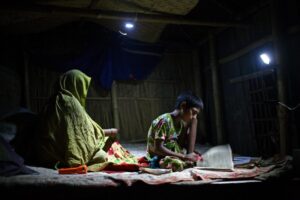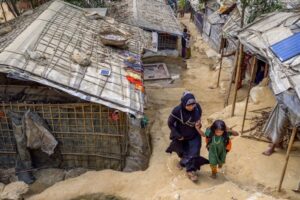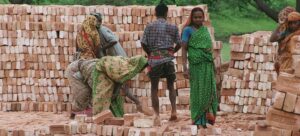by N N Tarun Chakravorty and Subho Basu 19 January 2022
Bangladesh already drew the attention of the international community to its growth and development when she celebrated her 50 years of independence in 2021. It’s a good idea to compare Bangladesh’s development to Pakistan’s as it separated from the latter owing to the dominance and exploitation inflicted upon the former. Bangladesh started from a much lower position in economic, developmental and social indicators with an economy devastated by the Pakistani army during the war of independence; the new country lacked basic infrastructure and institutions.
In 1971 the industrial sector in Bangladesh (the erstwhile East Pakistan) accounted for 6–7% of its GDP while that in West Pakistan accounted for over 20%. By 2016, industries contributed 28.77% of the GDP in Bangladesh while the figures for Pakistan, India and the South Asian average were 19.36, 28.85 and 27.8%, respectively. In 2020 Bangladesh’s GDP rose to 329.12 billion dollars while Pakistan’s amounted to around 262.8 billion.
However, there are caveats and questions about the development achieved by Bangladesh. There is a lot of political investment in the term, development in Bangladesh. Almost all politicians and government leaders employ the term to sell their project of economic transformation to the people. So much so that the word ‘development’ has become an empty celebratory term. To government leaders, there is an easy equation between development and economic growth. Economic growth is a misleading indicator of the living standard of ordinary people in a society. This is almost axiomatic in development economics and yet there is an unhealthy tendency in Bangladesh government circles to tout economic growth as the most significant indicator of development. Thus, when we say that development has taken place in Bangladesh, we do not ask a more important question: whose development? Development for the few or development for the majority of the society? Indeed, in development economics, this phrase is very common: development for the few or development for all? Development might be the aim of a state but the aim of life is not merely development. Rather, the aim of life is to be happy and to be able to lead a peaceful life. From this point of view, in development economics the term, Gross Domestic Happiness instead of Gross Domestic Product has been in use for a long time.
American journalist, Mr. Nicholas Kristof wrote an article in New York Times on March 10, 2021 under the title of “What Can Biden’s Plan Do for Poverty? Look to Bangladesh”. In it, he advised President Joe Biden to learn from Bangladesh on how to alleviate poverty. The Economist termed Bangladesh’ development as a riddle. Bengali economist Prof. Kaushik Basu in his article “Why Bangladesh Booming” published in The Project Syndicate, hugely admired Bangladesh’s progress.
Nobel Laureate economist Professor Amartya Sen, who was born in Bangladesh, refers to Bangladesh as a success story in most of his writings and speeches regarding development. But the question we tend to pose is: how ‘happy’ are the ordinary citizens of Bangladesh, who have to toil hard to earn their bread? By the term ‘happy’ we mean socially meaningful happiness.
Professor Sen has defined the term development as removal of hindrances towards realization of life’s opportunities. But opportunities for those who oppose the government in Bangladesh, has been a far cry. Abductions and extrajudicial killings became regular practices by the government forces. At least 1,920 cases were documented from January 2009 to December 2018. Over the same period, 126 people died as a result of custodial torture and dozens became permanently disabled as a result of kneecappings while in police custody.
We often tend to consider only macroeconomic indicators and miss out indicators such as democracy, individual freedom, existence of opposition parties in the parliament, free media, freedom of speech, independent instruments of the state organ, being the integral parts of Sen’s concept of development, which are totally absent in Bangladesh now. Why Sen doesn’t support the Soviet brand of socialism is because of the absence of these phenomena. At the same time, he straightaway rejects the neo-liberal mantra that ‘Market is God’ because such emphasis on the market ignores provisions of free education, free healthcare and social safety net for the poor, and measures to reduce inequality. True, Bangladesh achieved some development in the education sector but totally failed in ensuring healthcare and social safety net, and in reducing inequality.
Freedom House, a Washington-based research organization designated Bangladesh as a partly free country in 2020. No international agencies recognized Bangladesh’s general elections in 2014 and 2018. Bangladesh’s rank in the list of countries produced by the Freedom House of course reflects those two general elections. Bangladesh doesn’t even exist in the list of democracy index produced by this organization. In the global freedom index Bangladesh ranks 39 which is the ninth from the bottom. In political right and civil liberty Bangladesh obtains only 15 and 24, which is the ninth from the bottom whereas the top scores in these categories are 34 and 33 respectively. Tanzania having the scores of 12 and 22 stands the lowest. Notable is that Bhutan, despite a monarchy, positions itself around the top of the freedom index, political right index and civil liberty index.
While knowledge is the basis of development, Bangladesh performs very poorly in the Global Knowledge Index 2020: Bangladesh’s position is the lowest in South Asia and ranks 112 among 138 countries. It is alarming because it indicates a shallow education system. Needless to say, development requires a strong industrial base, financial technology and a rich superstructure, for which a deep and flawless education system is a must.
Is inequality a problem? Dr. Vitaly, a professor of Economics at Moscow State University has witnessed both the Soviet System and the present capitalist Russia, explains, through ‘demonstration effect’ theory, that inequality makes people unhappy. According to Wealth-X, a US institute, reveals that from 2012 onwards in 5 years the number of billionaires has increased at 17%. Bangladesh has now surpassed China in respect of the increase in the number of billionaires. At the same time, in respect of the number of extreme poor, Bangladesh, having 24.1 million, now ranks 5th position in the world. It means that Bangladesh is the most unequal country in the world. Equality among humans is the basis of the theory of justice formulated by Professor John Rawls who Sen considers his guru.
As regards to subjective well-being or happiness Professor Sen further explains that humans want to see their existence as meaningful, desire to see that the society and the state consider their existence important. There should be such a system where people should be able to do whatever they want to do on their own; otherwise, they cannot be happy. The Amartyan concept of happiness transcends the mere utility extracted from their economic activities; it rather calls for a pure joy through fulfilling their desired social activities. Amartya suggests that humans enjoy self-independence and that the state, the society and the family do not interfere in an individual’s own domain; otherwise, they cannot be happy. Amartya goes on and says that happiness does not depend on their own happiness alone because humans feel happy seeing others happy as well. Here lies the necessity of ensuring equality in the society. In sum, happiness does not depend on only one’s own happiness; it depends on the happiness of others, on the society, on the collective, on the environment prevailing around, on the overall condition of the whole world.
From this viewpoint, is Sen’s favourite country, Bangladesh, a happy country? No doubt, there is growth, there is affluence, there is upward mobility in the developmental indices but there is no happiness because it depends on a multitude of other factors. For the people to be happy they must have the right to vote, right to wealth, right to gather and the right to live one’s life in his or her own way. But the people in Bangladesh do not enjoy these rights at all. Not only one’s own happiness but also the happiness extracted from seeing others happy, makes people happy but the sky-high inequality prevailing in the society has made it impossible in Bangladesh. GDP per capita in the USA is higher than that in the Scandinavian countries but the citizens of the latter are happier than those of the former. This is because inequality is much lower in the Scandinavian countries.
True, Bangladesh government from 1991 onwards took a lot of developmental measures especially in women education although the main job of women education and women empowerment are accomplished by the NGOs. Women in Bangladesh have made their motherland indomitable in the international apparel market and brought revolution inside the country. Bangladeshi workers have been continuously increasing the reserves of the central bank through remittances even during the pandemic. Peasants have continued to toil hard and increase production even after the advent of COVID-19. Therefore, the main architect of Bangladesh’s development is the working people yet Bangladesh is one of the countries where the working class is the least paid. Those who are mesmerised by the stories of development from above, don’t know the real stories lying beneath the apparent gloss. They don’t know that social inequality, rampant corruption and periodic denial of human rights to workers constitute a significant aspect of this development.




